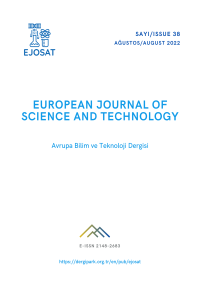Öz
In this study, it was aimed to prepare and analyze an environmentally friendly adsorbent because fluoride in water is an important health threat affecting the whole world. ZnO doped chitosan adsorbent was produced for fluorine adsorption. The characterization of the adsorbent was done by FT-IR, SEM-EDX analysis. The effects of pH, initial concentration, amount of adsorbent on adsorption were investigated. Langmuir and Temkin isotherm models were studied and Langmuir was found to be the most compatible isotherm. The maximum adsorption amount was calculated as 3.67 mg/g according to Langmuir isotherm.
Anahtar Kelimeler
Kaynakça
- Alhosseini, S. N., Moztarzadeh, F., Mozafari, M., Asgari, S., Dodel, M., Samadikuchaksaraei, A., Kargozar, S., & Jalali, N. (2012). Synthesis and characterization of electrospun polyvinyl alcohol nanofibrous scaffolds modified by blending with chitosan for neural tissue engineering. International Journal of Nanomedicine, 7, 25.
- Das, N., Pattanaik, P., & Das, R. (2005). Defluoridation of drinking water using activated titanium rich bauxite. Journal of Colloid and Interface Science, 292(1), 1–10. https://doi.org/https://doi.org/10.1016/j.jcis.2005.06.045
- Fan, X., Parker, D. J., & Smith, M. D. (2003). Adsorption kinetics of fluoride on low cost materials. Water Research, 37(20), 4929–4937. https://doi.org/https://doi.org/10.1016/j.watres.2003.08.014
- Ghorai, S., & Pant, K. K. (2004). Investigations on the column performance of fluoride adsorption by activated alumina in a fixed-bed. Chemical Engineering Journal, 98(1), 165–173. https://doi.org/https://doi.org/10.1016/j.cej.2003.07.003
- Kavci, E., Erkmen, J., & Bingöl, M. S. (2021). Removal of methylene blue dye from aqueous solution using citric acid modified apricot stone. Chemical Engineering Communications, 1–16.
- Li, Y.-H., Wang, S., Zhang, X., Wei, J., Xu, C., Luan, Z., & Wu, D. (2003). Adsorption of fluoride from water by aligned carbon nanotubes. Materials Research Bulletin, 38(3), 469–476. https://doi.org/https://doi.org/10.1016/S0025-5408(02)01063-2
- Lv, L., He, J., Wei, M., Evans, D. G., & Zhou, Z. (2007). Treatment of high fluoride concentration water by MgAl-CO3 layered double hydroxides: Kinetic and equilibrium studies. Water Research, 41(7), 1534–1542. https://doi.org/https://doi.org/10.1016/j.watres.2006.12.033
- Medellin-Castillo, N. A., Leyva-Ramos, R., Ocampo-Perez, R., Garcia de la Cruz, R. F., Aragon-Piña, A., Martinez-Rosales, J. M., Guerrero-Coronado, R. M., & Fuentes-Rubio, L. (2007). Adsorption of Fluoride from Water Solution on Bone Char. Industrial & Engineering Chemistry Research, 46(26), 9205–9212. https://doi.org/10.1021/ie070023n
- Meenakshi, S., Sundaram, C. S., & Sukumar, R. (2008). Enhanced fluoride sorption by mechanochemically activated kaolinites. Journal of Hazardous Materials, 153(1), 164–172. https://doi.org/https://doi.org/10.1016/j.jhazmat.2007.08.031
- Meenakshi, S., & Viswanathan, N. (2007). Identification of selective ion-exchange resin for fluoride sorption. Journal of Colloid and Interface Science, 308(2), 438–450. https://doi.org/https://doi.org/10.1016/j.jcis.2006.12.032
- Miretzky, P., & Cirelli, A. F. (2011). Fluoride removal from water by chitosan derivatives and composites: A review. Journal of Fluorine Chemistry, 132(4), 231–240. https://doi.org/https://doi.org/10.1016/j.jfluchem.2011.02.001
- Nagaraju, G., Udayabhanu, Shivaraj, Prashanth, S. A., Shastri, M., Yathish, K. v, Anupama, C., & Rangappa, D. (2017). Electrochemical heavy metal detection, photocatalytic, photoluminescence, biodiesel production and antibacterial activities of Ag–ZnO nanomaterial. Materials Research Bulletin, 94, 54–63. https://doi.org/https://doi.org/10.1016/j.materresbull.2017.05.043
- Roy, S., & Dass, G. (2013). Fluoride contamination in drinking water–a review. Resour. Environ, 3(3), 53–58.
Öz
Bu çalışma, sulardaki Florürün bütün dünyayı etkileyen önemli bir sağlık tehdidi olması nedeniyle çevre dostu bir adsorbentin hazırlanarak incelenmesi amaçlanmıştır. ZnO katkılı kitosan adsorbenti Flor adsorpsiyonu için üretildi. Adsorbentin karakterizasyonu FT-IR, SEM-EDX analizler ile yapılmıştır. pH, başlangıç konsantrasyonu, adsorbent miktarının adsorpsiyon üzerine etkisi araştırıldı. Langmuir ve Temkin isotherm modelleri çalışıldı ve en uyumlu isothermin Langmuir olduğu bulunmuştur. Langmuir isothermine göre maksimum adsorpsiyon miktarının 3,67 mg/g olarak hesaplanmıştır.
Anahtar Kelimeler
Kaynakça
- Alhosseini, S. N., Moztarzadeh, F., Mozafari, M., Asgari, S., Dodel, M., Samadikuchaksaraei, A., Kargozar, S., & Jalali, N. (2012). Synthesis and characterization of electrospun polyvinyl alcohol nanofibrous scaffolds modified by blending with chitosan for neural tissue engineering. International Journal of Nanomedicine, 7, 25.
- Das, N., Pattanaik, P., & Das, R. (2005). Defluoridation of drinking water using activated titanium rich bauxite. Journal of Colloid and Interface Science, 292(1), 1–10. https://doi.org/https://doi.org/10.1016/j.jcis.2005.06.045
- Fan, X., Parker, D. J., & Smith, M. D. (2003). Adsorption kinetics of fluoride on low cost materials. Water Research, 37(20), 4929–4937. https://doi.org/https://doi.org/10.1016/j.watres.2003.08.014
- Ghorai, S., & Pant, K. K. (2004). Investigations on the column performance of fluoride adsorption by activated alumina in a fixed-bed. Chemical Engineering Journal, 98(1), 165–173. https://doi.org/https://doi.org/10.1016/j.cej.2003.07.003
- Kavci, E., Erkmen, J., & Bingöl, M. S. (2021). Removal of methylene blue dye from aqueous solution using citric acid modified apricot stone. Chemical Engineering Communications, 1–16.
- Li, Y.-H., Wang, S., Zhang, X., Wei, J., Xu, C., Luan, Z., & Wu, D. (2003). Adsorption of fluoride from water by aligned carbon nanotubes. Materials Research Bulletin, 38(3), 469–476. https://doi.org/https://doi.org/10.1016/S0025-5408(02)01063-2
- Lv, L., He, J., Wei, M., Evans, D. G., & Zhou, Z. (2007). Treatment of high fluoride concentration water by MgAl-CO3 layered double hydroxides: Kinetic and equilibrium studies. Water Research, 41(7), 1534–1542. https://doi.org/https://doi.org/10.1016/j.watres.2006.12.033
- Medellin-Castillo, N. A., Leyva-Ramos, R., Ocampo-Perez, R., Garcia de la Cruz, R. F., Aragon-Piña, A., Martinez-Rosales, J. M., Guerrero-Coronado, R. M., & Fuentes-Rubio, L. (2007). Adsorption of Fluoride from Water Solution on Bone Char. Industrial & Engineering Chemistry Research, 46(26), 9205–9212. https://doi.org/10.1021/ie070023n
- Meenakshi, S., Sundaram, C. S., & Sukumar, R. (2008). Enhanced fluoride sorption by mechanochemically activated kaolinites. Journal of Hazardous Materials, 153(1), 164–172. https://doi.org/https://doi.org/10.1016/j.jhazmat.2007.08.031
- Meenakshi, S., & Viswanathan, N. (2007). Identification of selective ion-exchange resin for fluoride sorption. Journal of Colloid and Interface Science, 308(2), 438–450. https://doi.org/https://doi.org/10.1016/j.jcis.2006.12.032
- Miretzky, P., & Cirelli, A. F. (2011). Fluoride removal from water by chitosan derivatives and composites: A review. Journal of Fluorine Chemistry, 132(4), 231–240. https://doi.org/https://doi.org/10.1016/j.jfluchem.2011.02.001
- Nagaraju, G., Udayabhanu, Shivaraj, Prashanth, S. A., Shastri, M., Yathish, K. v, Anupama, C., & Rangappa, D. (2017). Electrochemical heavy metal detection, photocatalytic, photoluminescence, biodiesel production and antibacterial activities of Ag–ZnO nanomaterial. Materials Research Bulletin, 94, 54–63. https://doi.org/https://doi.org/10.1016/j.materresbull.2017.05.043
- Roy, S., & Dass, G. (2013). Fluoride contamination in drinking water–a review. Resour. Environ, 3(3), 53–58.
Ayrıntılar
| Birincil Dil | Türkçe |
|---|---|
| Konular | Mühendislik |
| Bölüm | Makaleler |
| Yazarlar | |
| Erken Görünüm Tarihi | 26 Temmuz 2022 |
| Yayımlanma Tarihi | 31 Ağustos 2022 |
| Yayımlandığı Sayı | Yıl 2022 Sayı: 38 |

